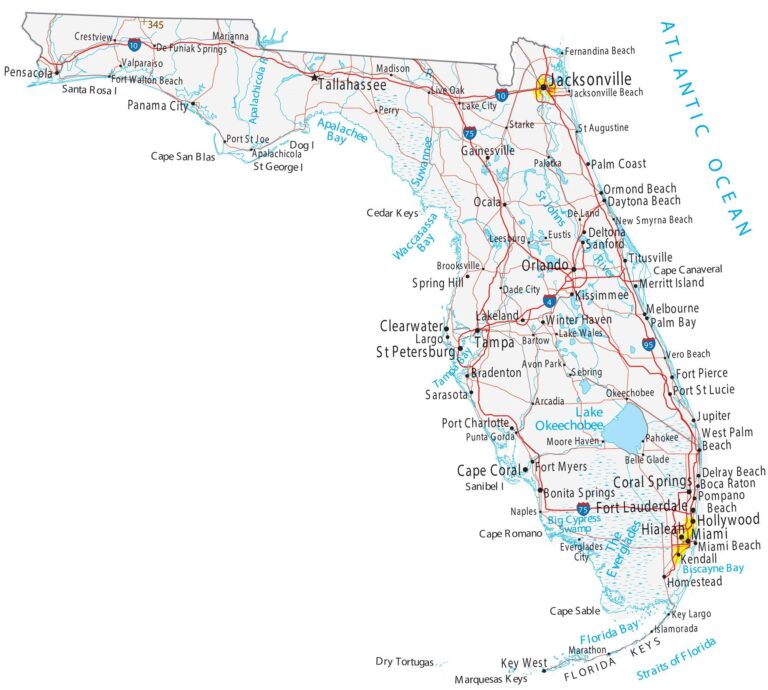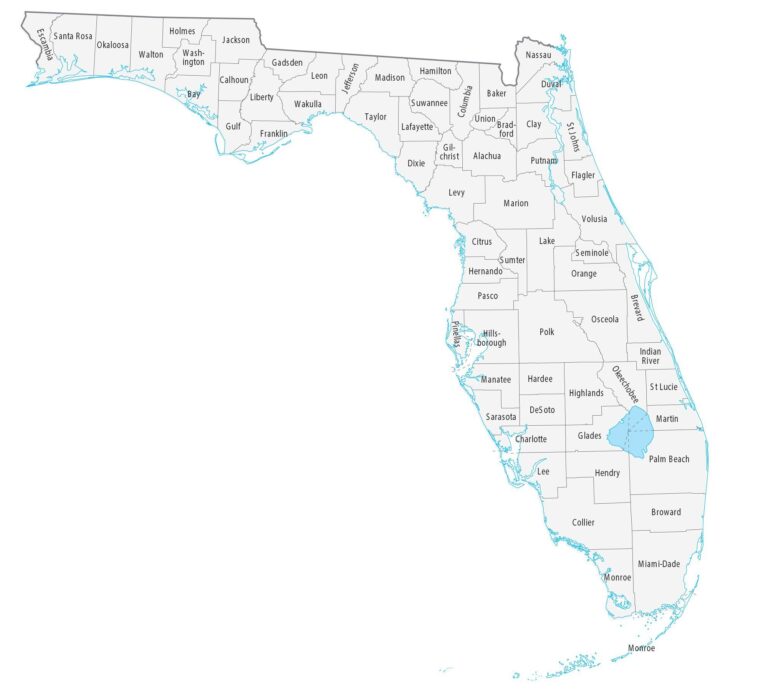Florida is a state located in the southeastern region of the United States, bordered by the Gulf of Mexico to the west and the Atlantic Ocean to the east. Known for its sunny weather, beautiful beaches, and diverse attractions, Florida is a popular destination for tourists from all over the world. From theme parks and nature reserves to historic landmarks and cultural attractions, Florida offers something for everyone.
As a popular tourist destination, Florida has a significant impact on the state’s economy. The tourism industry provides employment for millions of people and generates billions of dollars in revenue each year. With its warm climate, beautiful scenery, and wealth of attractions, Florida is truly a unique and important destination for visitors.
Capital |
Tallahassee |
Area |
65,758 sq mi (170,312 sq km) |
Population |
~ 2.18 crores |
Abbreviations |
FL |
National parks |
Everglades,Dry Tortugas, Biscayne |
Islands of Florida |
Key West,Sanibel Island,Captiva Island,Amelia Island,Marco Island,Siesta Key,Anna Maria Island,Gasparilla Island,Key Largo,Bahia Honda |
Major cities and towns
| Jacksonville | Pembroke Pines |
| Miami | Hollywood |
| Tampa | Miramar |
| Orlando | Gainesville |
| St. Petersburg | Coral Springs |
| Hialeah | Clearwater |
| Tallahassee | Palm Bay |
| Fort Lauderdale | Miami Gardens |
| Port St. Lucie | West Palm Beach |
| Cape Coral | Pompano Beach |
Interstate highways
- I-4: Connects Tampa, Orlando, and Daytona Beach in central Florida
- I-10: Connects Pensacola, Tallahassee, and Jacksonville in northern Florida
- I-75: Connects Tampa, Gainesville, and Ocala in central Florida, and continues north to Atlanta, Georgia
- I-95: Runs along the east coast of Florida, connecting Miami, Fort Lauderdale, West Palm Beach, Daytona Beach, and Jacksonville
- I-275: Connects St. Petersburg and Tampa in central Florida
- I-295: Connects Jacksonville and the surrounding areas in northeastern Florida.
Populated places in Florida
| Jacksonville | Hollywood |
| Miami | Gainesville |
| Tampa | Coral Springs |
| Orlando | Clearwater |
| St. Petersburg | Palm Bay |
| Hialeah | West Palm Beach |
| Tallahassee | Pompano Beach |
| Port St. Lucie | Lakeland |
| Cape Coral | Miami Beach |
| Pembroke Pines | Davie |
History of Florida
Florida has a rich and diverse history that spans thousands of years. The state was originally inhabited by various Native American tribes, including the Calusa, Apalachee, and Timucua. These tribes developed complex societies and traded with other groups throughout the region.
In 1513, Spanish explorer Juan Ponce de León arrived in Florida and claimed the land for Spain. Over the next few centuries, the Spanish established numerous colonies in Florida, including St. Augustine, the oldest continuously inhabited city in the United States.
In 1821, Florida became a territory of the United States and was eventually admitted as the 27th state in 1845. During the Civil War, Florida seceded from the Union and became part of the Confederacy, but was later readmitted to the Union in 1868.
Since then, Florida has experienced significant growth and development, becoming a major tourist destination and one of the fastest-growing states in the country. Today, Florida is known for its beaches, theme parks, and diverse cultural offerings.
Florida Counties
Florida is divided into 67 counties, each with its own unique character and attractions. Some of the most popular counties for tourists include:
- Miami-Dade County: Home to Miami and its famous beaches, nightlife, and cultural attractions.
- Orange County: Known for Orlando and its theme parks, including Disney World and Universal Studios.
- Broward County: Home to Fort Lauderdale and its beaches, as well as the Everglades National Park.
- Palm Beach County: Known for its upscale resorts, golf courses, and beaches.
- Hillsborough County: Home to Tampa and its historic Ybor City neighborhood, as well as Busch Gardens theme park.
- Pinellas County: Home to St. Petersburg and its museums, galleries, and beaches.
- Duval County: Home to Jacksonville and its historic sites, parks, and beaches.
- Monroe County: Known for the Florida Keys and its coral reefs, fishing, and boating.
- Lee County: Home to Fort Myers and its beaches, as well as the Sanibel and Captiva Islands.
- Sarasota County: Known for its cultural attractions, including museums, theaters, and galleries, as well as its beaches.
Florida Area Codes
Florida has several area codes assigned to different regions. Here are some of the most commonly used area codes in Florida:
- 305: Covers the Miami-Dade County and the Florida Keys.
- 407: Covers Orlando and the central Florida region.
- 561: Covers Palm Beach County and the Treasure Coast.
- 727: Covers the Tampa Bay area, including St. Petersburg and Clearwater.
- 786: Covers Miami-Dade County, including the city of Miami.
- 813: Covers the Tampa Bay area and Hillsborough County.
- 850: Covers the Florida Panhandle, including Tallahassee and Pensacola.
- 904: Covers Jacksonville and the northeast Florida region.
- 941: Covers Sarasota and the southwestern Florida region.
- 954: Covers Broward County and Fort Lauderdale.
Florida Zip Codes
Florida has more than 1,000 zip codes that cover different cities, towns, and counties across the state. Some of the major cities and their corresponding zip codes are:
- Miami: 331xx, 332xx
- Orlando: 328xx, 328xx
- Tampa: 336xx, 337xx
- Jacksonville: 320xx, 322xx
- Fort Lauderdale: 333xx, 333xx
- Tallahassee: 323xx, 323xx
- Sarasota: 342xx, 342xx
- Pensacola: 325xx, 325xx
Florida Airports
- Orlando International Airport (MCO) – located in Orlando, this is the busiest airport in Florida and one of the busiest in the United States. It serves as a gateway to Central Florida and its many theme parks and attractions.
- Miami International Airport (MIA) – located in Miami-Dade County, this is the second-busiest airport in Florida and a major hub for international flights.
- Tampa International Airport (TPA) – located in Tampa, this airport serves the west coast of Florida and is known for its efficient design and easy navigation.
- Fort Lauderdale-Hollywood International Airport (FLL) – located in Broward County, this airport serves the Greater Fort Lauderdale area and is a popular gateway to the beaches and nightlife of South Florida.
- Southwest Florida International Airport (RSW) – located in Fort Myers, this airport serves the Gulf Coast of Florida and is a popular destination for vacationers looking for sun, sand, and relaxation.
- Palm Beach International Airport (PBI) – located in West Palm Beach, this airport serves the Palm Beaches and is a popular gateway to the luxury and opulence of South Florida.
- Jacksonville International Airport (JAX) – located in Jacksonville, this airport serves the northeast corner of Florida and is a popular destination for business travelers and tourists alike.
- Sarasota-Bradenton International Airport (SRQ) – located in Sarasota, this airport serves the Gulf Coast of Florida and is known for its convenient location and easy access to some of the state’s best beaches.
Florida National Parks
Florida is home to several national parks that offer a diverse range of natural and cultural experiences. Some of the most popular national parks in Florida include:
- Everglades National Park: This park is home to a unique ecosystem of marshes, swamps, and forests, and is the only place in the world where alligators and crocodiles coexist.
- Biscayne National Park: This park includes coral reefs, islands, and mangrove forests, and is home to a variety of marine life, including dolphins, sea turtles, and tropical fish.
- Dry Tortugas National Park: This park is located on a remote island in the Gulf of Mexico, and features a historic fort, pristine beaches, and some of the best snorkeling and diving opportunities in the country.
- Big Cypress National Preserve: This preserve is home to a vast expanse of swampland and cypress forests, as well as a diverse array of wildlife, including panthers, bears, and alligators.
- Gulf Islands National Seashore: This park includes miles of pristine beaches and dunes, as well as historic forts and natural habitats for a variety of wildlife species.
- Castillo de San Marcos National Monument: This historic fort, located in St. Augustine, was built by the Spanish in the 17th century and played a key role in the early history of Florida.
Florida Geography
Florida is a state located in the southeastern region of the United States. It is bordered by Alabama to the northwest and Georgia to the northeast. The state is known for its long coastline, beautiful beaches, and warm weather.
Florida has a diverse landscape that includes wetlands, forests, swamps, and coral reefs. The state’s geography is characterized by its many lakes, rivers, and springs, as well as the Everglades, which is the largest subtropical wilderness in the United States.
Florida is also home to several important geological formations, including the Okefenokee Swamp, the Apalachicola River, and the Karst topography found in the northern part of the state. The state’s many barrier islands, including the Florida Keys, provide important habitats for a wide range of plant and animal species.
Overall, Florida’s geography is both unique and diverse, making it an ideal destination for those who love outdoor adventures and nature exploration.
Florida Climate
Florida has a humid subtropical climate, with hot and humid summers and mild winters. Temperatures in the summer months can reach the high 80s and low 90s Fahrenheit (around 30-33 degrees Celsius), while winter temperatures average in the 60s Fahrenheit (15-20 degrees Celsius). Florida is also known for its frequent thunderstorms, particularly during the summer months, and is vulnerable to hurricanes during the Atlantic hurricane season, which runs from June 1st to November 30th.
Faqs on Florida
1. What is the capital of Florida?
Ans: The capital of Florida is Tallahassee.
2. What is the population of Florida?
Ans: As of 2021, the estimated population of Florida is approximately 21.7 million.
3. What is the largest city in Florida?
Ans: The largest city in Florida by population is Jacksonville.
4. What is the official language of Florida?
Ans: The official language of Florida is English.
5. What is the time zone in Florida?
Ans: Most of Florida is in the Eastern Time Zone (ET), while the westernmost parts of the Florida panhandle are in the Central Time Zone (CT).
6. What is Florida known for?
Ans: Florida is known for its warm climate, beautiful beaches, amusement parks (such as Disney World and Universal Studios), oranges, and alligators.
7. What are some popular tourist attractions in Florida?
Ans: Some popular tourist attractions in Florida include Disney World, Universal Studios, South Beach in Miami, the Kennedy Space Center, and the Everglades National Park.
8. What is the weather like in Florida?
Ans: Florida has a humid subtropical climate, with hot and humid summers and mild winters. It is also known for its frequent thunderstorms and hurricanes during the summer and fall months.
9. What sports teams are in Florida?
Ans: Florida has professional sports teams in various leagues, including the Miami Heat (NBA), Miami Marlins (MLB), Tampa Bay Buccaneers (NFL), Tampa Bay Rays (MLB), and Florida Panthers (NHL).


